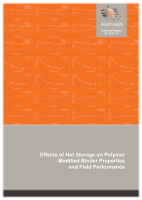Pavement

- Publication no: AP-T271-14
- ISBN: 978-1-925037-78-4
- Published: 8 September 2014
- PDF (free) Download
Polymer modified binders (PMBs) are increasingly used in road construction as they provide enhanced performance properties compared with conventional bitumen. Even though PMBs show enhanced service properties, they may show degradation or changes in test properties during hot storage. This study investigated the effects of hot storage on the conventional test properties and field performance of PMBs containing low (3.5% by weight) and high (6% by weight) levels of styrene-butadiene-styrene (SBS) polymer. The chemical changes that occurred in the PMBs during storage were also studied.
The results obtained for the two PMBs indicated that the SBS polymer in both PMBs was breaking into smaller fragments when they were stored for a prolonged period at 180 °C. There was a reduction in most conventional PMB test results when the PMB containing 6% SBS polymer was stored for an extended period. The conventional PMB test properties of the PMB containing 3.5% SBS polymer did not vary in a regular way as the storage time at 180 °C was increased, as some test properties did not change while others either increased or decreased. Even though the polymer in both PMBs was degrading during storage there was no change in the wheel tracking performance of the PMB containing 6% SBS in asphalt for storage periods up to five days. The wheel tracking performance of the PMB containing 3.5% SBS in asphalt was also better after two and four days of storage than after no days of storage. The fatigue performance of both PMBs in asphalt also improved when the materials were stored.
The results obtained in this study appear to indicate that degradation of the polymer in a PMB during hot storage may not necessarily reduce the performance of material on the road. Based on the information available to date, it does not appear fruitful to include a PMB degradation test in the Australian PMB specification at the current time which ranks SBS-based PMB binders in terms of their resistance to polymer degradation during hot storage.
- 1. Introduction
- 2. Experimental Design
- 2.1. Materials
- 2.2. PMB Sample Manufacture
- 2.3. Hot Storage Experiments
- 2.4. Binder Test Procedures
- 2.5. Fourier Transform Infrared (FTIR) Spectroscopy
- 2.6. Gel Permeation Chromatography (GPC)
- 2.7. Asphalt Mix Design and Test Procedures
- 3. High Polymer Content PMB
- 3.1. High Polymer Content PMB Test Properties
- 3.2. Changes in Binder Properties during Hot Storage
- 3.3. Comparison of Binder Property Changes with Other Studies
- 3.4. FTIR Measurements
- 3.5. GPC Measurements
- 3.6. Changes in Asphalt Performance during Hot Storage
- 3.7. High Polymer Content PMB Result Summary
- 4. Low Polymer Content PMB
- 4.1. Low Polymer Content PMB Test Properties
- 4.2. Changes in Binder Properties during Hot Storage
- 4.3. FTIR Measurements
- 4.4. GPC Measurements
- 4.5. Changes in Asphalt Performance during Hot Storage
- 4.6. Low Polymer Content PMB Result Summary
- 5. Further Investigations and Discussion
- 5.1. Differences in Test Property Changes between High and Low Polymer Content PMBs
- 5.1.1. Introduction
- 5.1.2. Contribution of the Polymer to PMB Test Results Prior to Hot Storage
- 5.1.3. Changes to the Test Properties of the Non-polymer Components in the PMBs during Hot Storage
- 5.1.4. Low Polymer Content PMB – Influence of Polymer and Non-polymer Components on Test Property Changes during Hot Storage
- 5.1.5. High Polymer Content PMB – Influence of Polymer and Non-polymer Components on Test Property Changes during Hot Storage
- 5.1.6. Summary
- 5.2. Effects of Polymer Degradation in PMBs on Field Performance
- 6. Conclusions
- References
- Appendix A Changes in PMB Test Properties on Storage
- Appendix B FTIR Chemical Assignments
